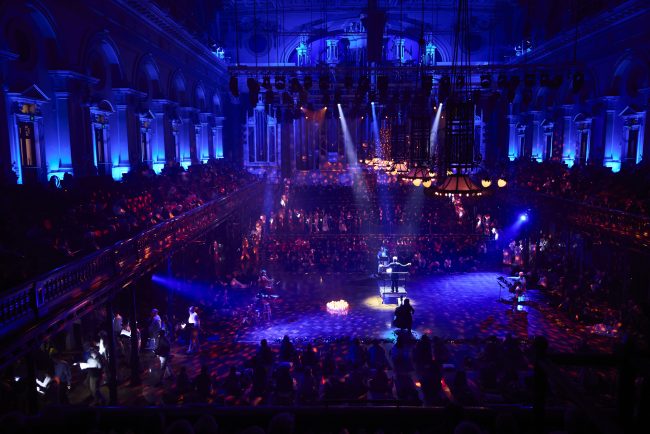Saturday July 20, 2024
Review by Paul Neeson (Arts Wednesday)

Not for the first time have we walked out of a Sydney Philharmonia Choirs concert feeling privileged that we had just witnessed something very special. Artistic Director, Brett Weymark’s curation of Rachmaninov’s All Night Vigil combined lighting, staging, extraordinary choral musicianship and improvisation (and did I mention yoga mats) to create a unique meditative and spiritual transcension to a place of sublime bliss.

Setting the mood. The floor of the Sydney Town Hall was covered in neatly arranged yoga mats that began to fill up with people carrying pillows – and some even with blankets. In the centre of the hall was a large empty square marked out with candles (battery operated I suspect but flickering atmospherically nonetheless). As the audience settled a few choristers drifted in carrying floral arrangements positioning them around the edges of the square. A pair of cellos and two double basses casually took up their places on the four sides of the square with the usual nonchalance you see at the prelude to any concert. But slowly they began to play. Are they just warming up? No the randomness over time morphed into something more regular as the Symphony Chorus appeared in ever increasing numbers and conductor, Tim Cunniffe mounted a podium in the centre that was on wheels. The lighting was just a few low key lights and the small lamps on the choir’s music scores. When the choir began hissing we realised that Deborah Cheetham Fraillon’s Acknowledgement to Country had begun.
Somehow the music seamlessly merged into the opening movement of Rachmaninov’s All Night Vigil. I don’t recall how that happened, but suddenly we were in a 1915 Russian Orthodox church. Two year’s after the premiere of this pinnacle of sacred music, the 1917 revolution dictated that all religious service (the opiate of the masses) was banned. The work was not recorded or performed again until the famous 1965 recording by the State Academic Russian Choir, but this was only available for export or study purposes.

The All Night Vigil consists of 6 movements of Vespers (traditionally at the setting of the sun), 8 movements of Matins (a celebration of Resurrection) followed by a final hymn to the Mother of God. Rachmaninov’s skill is taking the 10th century chants and turning them into a lush harmonic wonder with endless plays of vocal colour and textures. In some movements he even creates his own chants that are barely distinguishable from the ancient originals. This, apart from the fact that it is such a pleasurable aural experience, is why the All Night Vigil is considered a masterpiece. And we lapped it all up, as the sonority of the bass voices resonated through the hall providing a firmament for the heavenly sopranos and the constantly changing vocal layers. From darker moods of reflection to joyous exclamations of worship, it was a truly remarkable journey.

Between the movements the choir rearranged themselves into differing configurations, walking with a monastic solemness, sometimes creating paths for the two soloists, mezzo-soprano Hannah Fraser and tenor Louis Hurley to traverse. Conductor, Tim Cunniffe, did a remarkable job directing the choir as not only the choristers, but also his mobile podium, was constantly moving. The accompaniment to this constant motion was provided by musical segues composed by Brett Weymark and performed mostly by the cellos and double bases. The real surprise of the night was saxophonist Nicholas Russoniello who improvised and composed obligatos for soprano or baritone sax. What a delightful contrast as the high tones of the soprano sax soared above the lower strings. Towards the end of the work, Russoniello appeared on the actual stage (empty up to this point) with his large gleaming baritone sax and performed an extraordinary surprisingly contemporary solo. It was polyphonic with contrasting melodies in upper and lower registers with what sounded like vocalisations through the instrument, a bit like a didjeridu player. That caused a few of the prone bodies on yoga mats to raise their heads off the floor. In one movement (I think it was the 8th) tenor Louis Hurley was at the end of our row (upstairs) and the power and solidity of his voice was so present.
The lighting throughout reflected the mood of each movement, from golden glows to cool green washes and even dappled ‘animal print’ lighting. In the penultimate movement the choir began to leave the hall, some gathering the candles and positioning them in the centre of the room, while Russoniello played an exquisite extended solo on soprano saxophone. The lights dimmed, and only the light from 100 or so candles in the centre of the hall lit the remaining musicians. Then there was silence, and palpable expectation.

The final hymn of praise seeped quietly through the closed doors from the foyer before bursting into joyous ecstasy as the heavenly light shone through the glass and illuminated the darkened interior of the hall. Divine. Magic. Spiritual. Choose your own adjective but it would be inadequate to describe the emotions in the transfixed audience, who after a long moment of extended reverence began applauding, and applauding, and whistling, and shouting bravo. Maestro Weymark knows how to play the Sydney Town Hall like just another instrument in his musical arsenal.
Listen to a recent interview with Artistic Director, Brett Weymark below.
Share "Review: Rachmaninov’s All Night Vigil at the Sydney Town Hall"
Copy








